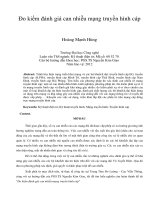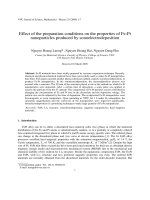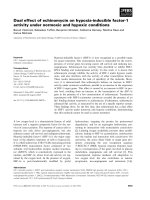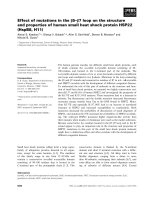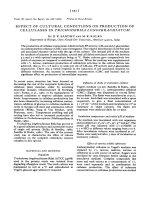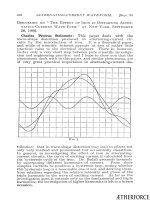Effect of cultural conditions on production of cellulases in trichoderma longibrachiatum
Bạn đang xem bản rút gọn của tài liệu. Xem và tải ngay bản đầy đủ của tài liệu tại đây (496.1 KB, 8 trang )
Trans. Br. mycol. Soc. 84 (2),
251-258
(1985)
Printed in Great Britain
EFFECT
OF
CUL
TURAL
CONDITIONS
ON
PRODUCTION
OF
CELLULASES
IN
TRICHODERMA
LONGIBRACHIATUM
By
D. K.
SANDHU
AND
M. K.
KALRA
Department of Biology, Guru
Nanak
Dev University,
Amritsar-is
joo
e, India
The
productionof cellulase components which include
FP
activity, CM-ase and p-glucosidase
on carboxymethyl cellulose
(CMC)
was investigated.
The
relative distribution of cell free
and
cell associated enzymes varied with
the
age of the culture.
The
optimal
pH
of the medium
for synthesis of enzymes in extracellular, cytosol and cell debris associated states was between
4'5 and 5"0 with optimal temperature being
27°C.
Shake cultures gave comparatively low
yields of enzymes as compared to stationary cultures.
When
the medium was supplemented
with 1
% lactose, maximum production of cellulolytic activities in the culture fiitrate was
achieved,
that
is, 8'1, 0·6
and
0'13 units
per
ml
of
CM-ase,
FP
activity and ,a-glucosidase
respectively.
There
was a varied response in the induction of cell associated enzymes by
different substrates. An increase in substrate concentration
(CMC
and lactose) had no
significant effect on production of extracellular enzymes.
In recent years, attention has been focused on
decreasing the cost of the enzymatic hydrolysis of
cellulosic plant material, either by screening
microbial mutants (Montenecourt
& Eveleigh,
1977; Farkas
et al., 1981) or by manipulation of
cultural conditions to improve cellulase enzyme
levels. Improvement in cellulase productivity has
also been obtained by increasing cellulose concen-
tration, addition of glucose to cellulose
medium
in
order
to increase cell mass and continuous culture
methods (Wilke, Yang
& Von Stockar, 1976;
Peitersen, 1977).
Temperature
profiling
and
pH
cycling have also led to increased production
of
cellulase in Trichoderma species (Mukhopadhyay &
Malik, 1980).
Trichoderma longibrachiatum Rifai has proved to
be a good cellulase producer and a potential source
of single cell protein (Sidhu
& Sandhu, 1980;
Sandhu
& Kalra, 1982).
The
aim of the present
study was to characterize the effect
of
culture
conditions on the complete cellulolytic enzyme
complex in this species.
MATERIALS
AND
METHODS
Organism
Trichoderma longibrachiatum Rifai
(ATCC
44788)
used in the present study was isolated from
degrading
Mangijera wood.
The
stock culture was
maintained in soil at 4 °C and subcultured in
Vogel's glucose agar whenever required.
Influence
of
shake or stationary cultures
Vogel's medium (25 ml)
(Sandhu
& Kalra, 1982)
supplemented with 1
% carboxymethyl cellulose
(CMC)
(Sigma) was dispensed in 100 ml Erlen-
meyerflasks.
The
flasks were autoclaved at 10 p.s.i.
for 20 min. Each flask was inoculated with a spore
suspension to give a final concentration of
5 x 10
6
ml? of the medium
and
incubated at 27° as
stationary or shake cultures. Six flasks
per
treatment were analysed daily for 10 days.
Incubation temperature and initial
pH
of
medium
The
medium was inoculated with test organisms
and incubated at 15°,22°,27°,32°,37°and 42°.
The
initial
pH
was adjusted with 0'1 N-NaOH or
0'1 N-HCl to different values ranging from 2 to 8.
After inoculation cultures were incubated at 27°.
Flasks were analysed after 5 days
of
incubation as
stationary cultures.
Effect of various soluble substrates
Carboxymethyl cellulose in Vogel's medium was
replaced by 1
% lactose, maltose, sucrose or
cellobiose as a sole source
of
carbon. Sugars were
sterilized by seitz filtration before adding to the
autoclaved medium. Complex compounds like
yeast and malt extract at a concentration of 1
%
were used separately
and
in combination for
cellulase production.
The
effect of substrate
concentrations on cellulase production was studied
RES
ULTS
Influence
of
carbon source
Among
the
carbon
sources tested
the
highest
extracellular enzyme activities were
recorded
with
lactose followed by
CMC
and
malt
extract (Fig. 4).
FP
activity
and
CM-ase
in
the
cytosol fraction were
found
to be
maximum
on
malt
extract
whereas
p-glucosidase was
maximum
on maltose
and
CMC.
Cellobiose gave
maximum
mycelial
dry
weight
and
was
found
to be
the
best source for cell debris
enzymes except for p-glucosidase
which
had
a
higher
activity in yeast extract.
No
CM-ase
activity
was detected on sucrose (Fig.
4b).
Of
the
different
concentrations
of
CMC,
t :5% gave
the
highest
Influence
of
pH
and temperature
Maximum
activity in
the
culture
filtrate was
recorded
at
pH
5"0.
The
pH
values lower
than
4'0
and
higher
than
5'5
had
an adverse effect on
cellulase
production
(Fig. 2a-c).
The
cytosol
and
cell debris enzymes were
maximum
between
pH
4-5
and
negligible at
pH
3'0
and
7'0
except
for
p-glucosidase (Fig.
z
c-c
).
The
enzymes in all
three
fractions were higher at 27°
but
best
.
growth
was
supported
at 32°
with
reasonable
amounts
of
enzymes also (Fig. 3a-c). At minimal
and
maximal
temperatures
tested, i.e. 15°
and
42°,
the
enzyme
components
in
the
extracellular
and
cytosol
fractions were
present
but
were
absent
in cell debris
excepting p-glucosidase.
Effect of shake and stationary culture on e
nzy
me
production
Th
e
production
of
the
three
components
of
cellulase in
the
culture
filtrate was
higher
in
stationary
culture
being 0'275,
1'64
and
0'10
units
ml-
1
and
0'17,
1'0
and
0'08
units
rnl'? in shake
culture
for
FP
activity,
CM-ase
and
p-glucosidase
respectively (Fig.
1
a,d,g
).
The
enzyme activities in
the
cytosol
and
cell debris fractions
appeared
earlier
and
were comparable
under
the
two
culture
conditions (Fig. 1b, c,
e,f
,h,1).
Enz
yme activities
have also been expressed for different fractions as
activity
per
flask (T able 1).
The
relative
proportions
of
the
enzyme in the above two fractions were
found
to be highest for p-glucosidase followed by
CM-ase
and
FP
activity.
The
activities in
the
cytosol
disappeared
after
the
eighth
day
but
persisted
in
the
cell debris
beyond
the
tenth
day.
The
maximum
mycelial mass was
obtained
on 4
and
6 days
of
incubation in shake
and
stationary
culture
respect-
ively.
The
pH
of
the
medium
showed a steady
increase towards
neutrality
after an initial decline.
Fractionation
of
samples
Each
sample was filtered
through
a
sintered
glass
funnel at 4°.
The
resulting
culture
filtrate was
centrifuged at 8500
g for 15
min
at 4°
and
stored
for analysis
of
enzyme activity
and
unused
substrate
.
The
cell mass was washed
with
0'1 M
acetate buffer at
pH
5"0
and
dried
between folds
of
filter
paper
.
The
above mycelium was frozen,
crushed
with chilled acid washed
sand
to
prepare
cytosol extracts
and
for cell debris fraction,
and
macerated
without
sand.
Both
fractions were
suspended
in buffer
and
centrifuged at 22000 g for
30
min
at 4°.
The
supernatant
was taken as
the
cytosol fraction while
the
pellet
of
cell debris
without
sand
was
resuspended
in 5 ml
of
buffer
and
stored
at - 15° if
not
immediately analysed.
25
2
Cellulases in
Trichoderma
longibrachiatum
in the case of lactose
and
CMC.
The
inoculated
flasks were
incubated
at 27° for 5 days as
stat
ionary
culture
s.
Dry weight determinations
Samples were
transferred
to
dried
and
preweighed
sintered
glass funnels
and
washed
thoroughly
with
cold deionized water.
These
were dried at 75° to a
constant
weight.
Enzyme unit
One
unit
of
enzyme activity is equivalent to 1 pM
of
product
released
per
min.
Cytosol
and
cell debris
enzymes have
been
expressed in
terms
of
specific
activity as
units
mg ?
protein
for cytosol
and
units
mg ?
dry
weight for cell debris.
The
sol-able
protein
content
was estimated by
the
method
of
Lowry
et al. (1951).
Estimation of enzymes
Filter
paper
activity
(FP
activity)
and
carboxy-
methyl
cellulase (CM-ase) were estimated as
described
earlier (Sandhu & Kalra, 1982) using
filter
paper
strips
and
CMC
as substrates.
For
p-glucosidase,
to
0'5 ml
of
the
diluted
enzyme
sample was
added
0'5 ml of 5
msr-p-nitrophenyl-
p-D-glucopyranoside (PNPG) (Sigma).
The
mix-
ture
was
incubated
at 37° for 30
min.
The
reaction
was
terminated
by
adding
4 ml
of
0'2
M-NaOH/
glycine buffer at
pH
10·6
and
the
absorbance read
at
420nm.
Carboxymethyl
cellulose in
the
culture
filtrate
was
determined
with
anthrone
reagent (U pdegraff,
19
69
).
D.
K.
Sandhu and
M.
K.
Kalra
253
0·35 2·1
0·28
(a)
(d)
(g)
~
•
r
r
1·5
4 1
»-
0·25
l'
-, 0·20
;<;::
E
- \-
,
.~
::>
~ -
~
a
eE
)i 4
0.12
»"Q)
0·15
,
0·9
N U
I \
<::
'"
1/
.',
/
• A
~
~t:
>(
.
.,
-V·,
\
~
,
j
"4-,.
It.
'
• •
l
0·05
0·3
./,
0·04
/~
'
./~
/ I
~/
,
0
~.
0
0·21
T"
(b)
•
(e)
(h)
'2
1\.
I I
.;;
I \
»-
_ 0
I \
.~
0·15
.~
0
•
l
",
. \
t)
t
I \
'"
""
:1\
I \
" E
~::>
l \
/ \
N -
0·09
I • •
<::
"0
, .
• I \
"-I
(!)
/!
\
I •
'.
>.
!/
\\
~
l'
~
I
~
I.
\ •
I
0·03
. .,
•
If
\.\
•
~I
'\
/
/
•
0
(j)
8 10
4 62
(i)
;,
.
.,{::::.,
.
!
~
"'.
I
I
I
•
l
/
8 10
6
Days
2 4
e-e_
/
'."·"'::1::1-·-·-1
.
-
/-
(c)
8 10
64
2
a
0·02
0·04
0·06
Fig.
1.
Production
of FP activity
(a-c),
CM-ase
(d-f),
p-glucosidase (g-l) in shake
( )
and stationary
( )
cultures on 1
';;0
CMcellulose.
254 Cellulases in
Trichoderma
longibrachiatum
Table
1 . Distribution
of
enzymes in three fractions
of
eellulases
Enzyme distribution
(units per flask)
Enzyme fraction
Extracellular
Cytosol
Cell-debris
FP
activity
7'0
0'045
0
'11
CM-ase
37'5
0'115
0
'24
,8-glucosidase
2'3
2
0'12
1'2
i
23 •
~
c:::
Co
E
i
c
Cl
35
5
IS
o
(a)
<.
I
"'.
•
15 22 27 32 37 42
Temperature
(DC
)
0·2
0·3
0·35
0·25
~
::E
u 0
.)5
.5
r
o
r
bIl
E
:::
0·24
~
~
0·20
u 0.16
r
E 0·12
2 0.16
.
'"
:§ 0·08
11
0
ee
b
><
~
o
30
I
20
~
'"
~
OIl
10 E
~
t-
O
(e)
(a)
(b)
23456
78
pH
0~ 1~""''''-''''''-'-~~ ,
~:~j
1·2
0·8
0·4
0·3
0·2
0·1
~
B 0·16
»
o
x
i
~
0·05
r
e 0·08
2
.
'"
:§
0-<, F 1f r-y
., , ""1
0;
o
e
';(
~
~
~
§ 0·35
r
bIl
E
2
~
'"
~
0·25
.5
r
o 0.15
Fig.
2. Effect of initial pH of medium on growth and
cellulase production in extraceIlular
(A.), cytosol (e ),
cell-debris
(0)
fractions; FP activity and growth (a),
CM-ase (b), /I-glucosidase (c). CM-ase and FPactivity in
cell-debris are plotted as activity x
10-
1
•
Fig. 3. Effect of temperature of incubation on growth and
cellulase production in extraceIlular
(A.), cytosol
(e
),
cell-debris (0 ) fractions;
FP
activity and growth (a),
CM-a
se (b), /I-glucosidase (c). CM-ase and FP activity in
cell-debris are plotted as activity x
10
-
1
.
D. K. Sandhu and M. K. Kalra
255
<
0-8
~
D:.
(a)
'0
<::
0·6
'"
<I)
'"
'1'
100
;:;a
u
0·4
r-
80
.5
60
S
r
Ol)
0
~LJh:
5
0·2
40
~
x
C
~
C
~.
Cl
'0
a
a
r
Ol)
5
~
10
>.,
~
:~
°tf
5
.0
(b)
o
<I)
I
'"
'0
<I) -
5
;;
~
>. u 0·6
N
.•
4
<::
.5
0·5
~ 2
0
~
0-4
Q.
.
r
Ol)
0·3
e
.
2
0·2
lL
.
[jl
0
0·1
•
'"
.9
• 0
0
>.
a
o
r
S
02
1
2
1
i
(c)
'"
~
"3
0·1
~
o
'"
lhl
tfB
~
A
~
• 0
~
• 0
<I)
a
'-'
~d)
'0
o
o
<::
1;l
'"
'"
'"
'"
1;l
<I)
0
<I)
<I) 0
><
><
u
'"
:E
'"
5"3
<I)
<I)
'"
<.>
.9 .9
.2
0
>.::::
'"
~
o
<;;
o
~
<I)
'"
;;
'"
~
'"
;:;a
;:I
o
<.>
<I)
;:;a
<I)
~
-l
U
CI)
-e
>-
<I)
"'
'"
a'l0i
u
>-;:;a
Fig. 4. Effect of various carbon sources on
growth
and
cellulase
production
in extracellular
(~),
cytosol
(.),
cell-debris
(0)
fractions;
FP
activity
and
growth
(a),
CM-ase
(b), p-glucosidase (c).
CM-ase
and
FP
activity
in cell-debris are
plotted
as activity x
10-'.
yield
of
all
the
extracellular enzymes (Fig. 5a-c). A
proportional
increase in cytosol
and
cell debris
enzymes was
recorded
with
increase in
the
substrate
concentration. All
the
cellulase
compon-
ents
in
the
three
fractions
reached
their
plateaux at
1-1'5
%
of
lactose
concentration
after
which
the
activities were almost
constant
(Fig.
6a-c).
Growth
expressed as
dry
weight increased
with
increase in
substrate
concentration
both
in
the
case
of
CMC
and
lactose,
the
increase being relatively small
above one
per
cent
(Figs
sa,
6a).
9
MYC
84
Cellulases in
Trichoderma
longibrachiatum
•
2·5
(e)
1·5 2·01·0
Concn of lactose (%)
____
- e
_.l A &
/&
0_
0
0-0
__
0
0_
0
0
0
0
(a)
.l
__
.l
__
.l
__
.l
./
120
e
I
-a
e
/-
80
.><:
'"
ea
<;::
00
•
E
40
~
.~ ~
~
7-
Cl
0
____
e
___
._e
0·5
(b)
__
.l
»>'
/
j
Fig. 6. Production of cellulase and growth at different
concentrations oflactose
in extracellular
(£),
cytosol
(.),
cell-debris
(0)
fractions;
FP
activity and growth (a),
CM-ase (b), ,8-glucosidase (e). CM-ase and
FP
activity in
cell-debris are plotted as activity x
10-'.
0·7
<
c,
e
~
I
-e
0·5
t::
e
'"
~
"
'"
'"
'"
<;::
=E
00
u
0·3
E
.S
~
i
~
0
c
x
0·1
';
~
"Cl
12
i
""
E
2
10
>.
.~"'
.L'
.
£;
~
8
~=:
" 8
E .•
6
~.~
t::
~
8
0.
0·4
r
eo
E
2
0·2
"0
'"
0
~
o
r
0·2
E
:2
0·12
'"
E
Q)
c
'"
!::
0·04
'!
2·50·5 1·0 1·5 2·0
Conen ofCMC (%)
o
0·4
40
(a)
<
0·3
30
p.,
~
~
"Cl
!j
<::
20
'"
0·2
1;l
'"
=E
u
.S
0·1
10
r
0
0_0 0
0
o-
X
';
e
-c
r
bO
2·0
E
2
~
(b)
",'
'':
/
~
~.L'
1·2
"
.:::
-e
"'0=
'"
"
o
a
"
E t::
0·4;>,
N "
t::
~
8
0·3
/
0.
r
eo
0·2
~==_o_o
E
2
0·1
0:"'
]
0
~
o
r
E
0·24
(e)
2
'
'"
"3
0·16
~
g
;<
~
0·08
-
-
"
/
0_
6
_0-
t o
Fig. 5. Production of cellulase and growth at different
concentrations of CMcellulose in extracellular
(£),
cytosol
(.),
cell-debris
(0)
fractions;
FP
activity and
growth
(a), CM-ase (b),,8 glucosidase (e). CM-aseand
FP
activity in cell-debris are plotted as activity x
10-'.
DISCUSSION
Extracellular enzyme
production
studies in
other
fungi (Boretti et ai., 1973;
D'Souza
&
Furtado,
1977) has
been
shown as linear
with
growth.
The
enzymes in
the
cytosol
and
cell debris fraction
contributed
minor
proportions of
FP
activity
and
eM-ase
but
reasonable
amounts
of p-glucosidase.
However, relative proportions
of
the
three
fractions
varied
during
growth
as
the
cell associated (cytosol
and
cell debris) reaction was
higher
in
the
early
phase compared to
the
late
growth
phase,
thus
indicating synthesis
and
release of these enzymes
into the
medium
which
added
to the concentration
D.
K.
Sandhu and
M.
K.
Kalra
257
of
extracellular enzymes (Berg &
Pettersson,
1977;
Kubicek,
1981, 1983).
Regarding
distribution
of
the
enzymes in
the
three
fractions
during
the
late
exponential
growth
phase,
most
of
the
FP
activity
and
CM-ase
(97'8, 99'1 %, respectively) were
located extracellularly.
Measurement
of
fJ-gluco-
sidase
showed
up
to 33 %
of
the
total activity to be
associated
with
the
mycelium
throughout
the
growth
period.
Halliwell &
Lovelady
(1981) have
reported
that
99'0
%
of
CM-ase
in T. koningii
Oudem.
is extracellular whereas 90 %
of
fJ-
glucosidase is associated
with
cells.
The
active
release
of
CM-ase
and
FP
activity
into
the
medium
in early stages
of
cultivation
of
T. reesei
Simmons
was
reported
by
Vaheri,
Vaheri &
Kaupinen
(1979)
with
fJ-glucosidase
being
detected
mainly
in
the
cell
debris
which
was
not
released
until
the
cells
had
autolysed.
In
different Trichoderma species,
which
are
the
most
promising
fungi for
industrial
production
of
cellulases,
most
of
the
,a-glucosidase
activity has
been
shown
as localized
within
the
cells
(Berg
&
Pettersson,
1977;
Kubicek,
1981)
except
in
the
cases
of
T. harzianumRifai
and
T. pseudokoningii
Rifai
where
high
levels
of
extracellular
enzymes
have
been
reported
(Sidhu,
1983).
Studies
on fungi
other
than
Trichoderma,
which
include
Penicillium
janthinellum
Biourge
and
Sporotrichum pulverulen-
tum
Burds.,
have also
shown
the
cell free
occurrence
of
fJ-glucanases
and
fJ-glucosidases
with
only small
amounts
associated
with
the
mycelium
(Eriksson
&
Hamp,
1978;
Rapp,
Grote
&
Wagner,
19
81).
The
cultural
conditions
have a
marked
effect on
the
production
of
enzymes
in all
three
fractions.
In
shake flasks
the
enzymes
reached
their
maximum
values earlier
but
the
activity was low
compared
with
stationary
cultures.
This
low activity
may
be
due
to inactivation
of
enzymes by shaking, as
reported
earlier
(Reese &
Mandels,
1980).
Maxi-
mum
production
of
cell free
and
cytosol
enzymes
was
obtained
at
pH
5'0
except
for
CM-ase
in
cytosol fraction
which
along
with
all cell
debris
activities
showed
a
pH
optimum
at 4'5.
Growth
and
enzyme
production
was
markedly
inhibited
when
the
initial
pH
was below
4'0
and
above
6'0.
This
pH
range
has also
been
reported
as
the
most
favourable
hydrogen
ion
concentration
for cellulolytic
enzyme
synthesis in several
other
fungi
namely,
Sclerotium
rolfsii
Sacco (Shewale &
Sadana,
1978), T.
reesei
(Andreotti
et al., 1980;
Mukhopadhyay
&
Malik,
1980), Pellicularia filamentosa (Pat.)
Rogers
(Tani-
guchiet
al., 1980),Eupenicilliumjavanicum (Beyma)
Stolk
&
Scott
(Tanaka
et al., 1980)
and
Aspergillus
terreus
Thom
(D'Souza
& Volfova, 1982). As
reported
in studies on T. viride
Pers.,
production
of
maximum
cell mass
may
not
produce
maximum
cellulase yield
(Andreotti
et al., 1980;
Mukhopad-
hyay, 1982).
The
observations
made
in
the
present
study
also
show
similar characteristics.
Here
the
growth
was
maximum
at 32° while
optimal
production
of
all cellulase
components
in
the
three
fractions was
maximum
at 27°.
Of
the
different
carbon
sources lactose gave
the
highest
yield
of
cellulase
enzymes
in
the
extracellular
medium
although
best
growth
was
supported
by
cellobiose.
In
earlier studies on Trichoderma species
lactose has
been
shown
to be a
good
inducer
(Andreotti
et al., 1980;
Kubicek,
1983).
In
Penicillium species too, it
produced
higher
amounts
of
fJ-glucosidase
but
gave
low
yields
of
other
cellulase
components
(Lakshmikanthan
&
jagan-
nathan,
1980).
Carboxymethyl
cellulose
proved
to
be less effective in
inducing
the
enzymes
compared
with
lactose
and
was
inhibitory
at
higher
concen-
trations.
This
may
be
due
to release
of
high
levels
of
glucose in
the
culture
broth
which
is a
known
repressor
of
cellulase.
Increasing
the
concentration
of lactose above 1 %
did
not
bring
about
a
significant increase in
enzyme
production
in
the
culture
filtrate.
The
three
cellulolytic enzymes in
the
cytosol
and
cell
debris
showed
differential
induction
by various
substrates.
This
location
of
enzymes in association
with
mycelium
or cell free
state has previously
been
shown
to
depend
upon
the
carbon
source (Berg, 1975; Berg &
Pettersson,
1977;
Chaudhury
&
Tauro,
1982).
In
the
present
study
the
induction
pattern
of
extracellular
and
cell-associated
enzymes
by various
carbon
sources
suggests
that
different
control
mechanisms
may be
operative
in
the
synthesis of
each
component
enzyme
of
cellulase.
The
authors
acknowledge
the
receipt
of
a
fellowship
from
Council
of
Scientific
and
Industrial
Research,
New
Delhi
to
one
of
us
(M.
K.
K.)
during
the
course
of
this
study.
REFERENCES
ANDREOTTI,
R.
E.,
MEDEIROS,
J.
E.,
ROCHE,
C. &
MANDELS,
M. (1980). Effect of
strain
and
substrate
on
production
of cellulases by Trichoderma reesei
mutants.
In
Proceedings of 2nd Bioconversion and Biochemical
Engineering Symposium
(lIT,
Delhi),
I (ed.
T.
K.
Ghose),
pp.
357-372.
BERG,
B. (1975).
Location
of cellulase in Cellvibrio fulvus
as
dependent
on
carbon
source
for
growth.
Canadian
Journal of Microbiology
21,
51-57.
BERG,
B. &
PETTERSSON,
G. (1977).
Location
and
formation
of cellulases in Trichoderma viride. Journal of
Applied Bacteriology 42,
65-75.
BORETTI,
G.,
GAROFANO,
L.,
MONTENECUCCHI,
P. &
SPALlA,
G. (1973). Cellulase
production
with
Penicillium
iriense. Archives of Microbiology 92,
189-200.
CHAUDHURY,
K. &
TAURO,
P. (1982). Selective
induction
of ,8-glucosidase in Trichoderma reesei by xylan.
Cellulases in
Trichoderma
longibrachiatum
European Journal of A pplied M icrobiology
and
Bi
otech-
nology
15, 185
-1
87.
D 'SOUZA, J.
& F
URTA
DO
, 1. (1977). Action of cellulase
from fungus of
marin
e origin in rice straw. Indian
Jou
rnal
of
Mic robiology 17, 194- 197·
D 'S OU
ZA
, J. & VOL
FOVA,
O. (1982).
The
effect of
pH
on
the
pr
oduct
ion of cellulases in A spergillus terreus.
European J ournal of Applied Microbio logy and B iotech-
nology
16, 123-125.
ERIK
SS
ON, K. E. & HAMP, S. (1978).
The
regulation of
endO-
l,4
-p-
glucanase p
roduct
ion in
Sp
orotrichum pul-
uerulentum. European
Jo
urnal
of
Biochemistry 90,
18
3-190
.
FARK
AS, V., LAB
UDOVA
, 1., BA
UER
, S. & FE
RE
NCZY,
L.
(1981).
Preparati
on of
mutant
s of Trichoderma viride
with increased
pr
oduct
ion
of
cellulase. Folia M icrobio-
logica
26, 129-132.
HALLI
WELL,
G . &
LOVELAD
Y,
].
(1981). Utilization
of
carboxymethyl cellulose
and
e
nzy
me synthesis by
Trichoderma koningii. Journal of General Microbiology
126
,211-
217
.
KUBICEK
, C. P. (1981). Release of carboxymethylcellulase
and
fl-glucosidase
from
cell walls of Trichoderma reesei.
European J ournal
of
Applied
M icrobiology and
Bi
otech-
nology
13
,226-231.
KUBIC
EK
, C. P. (1983). p-glucosidase excretion in
Trichoderma strains w
ith
diff
erent
cell wall b
ound
fl-
l,
3-glucanase activities. Canadian J ournal
of
M icro-
biology
29, 163-169.
LAKSHMIK
ANTH
AN
, B. C. & JA
GA
NNA
THA
N, V. (1980).
Purification
and
propert
ies of fl-glucosidase
of
Penicil-
lium f uniculosum.
In
Proceedings
of
znd Bioconversion
and Biochemical Engin eering S
ymp
osium (
lI
T ,
Delhi
), I
(ed ,
T.
K .
Gh
ose),
pp
. 145
-161.
LOWRY
, O. H. ,
ROSE
NBRO
UGH
, N . J .,
FARR
, A. L. &
RA
NDALL
, R. J. (1951).
Pr
otein
measur
em
ent
s with
fo
lin-ph
enol reagent. J ournal
of
Biological Chemistry
193,
26
5-
2
75.
MONT
ENE
CO
URT
, B. S. &
EVEL
EI
GH
, D . E. (1977).
Pre-
p
arat
ion of
mutants
of Trichoderma reesei with
enhanced
cellulase
pr
odu
ction.
Appli
ed a
nd
Environ-
mental M icrobiolo
gy
33, 777
-7
82.
M
UKHOP
ADHYAY,
S. N. (1982). Cellulase pr
oduction
and
lignocellulose saccharification.
In
Recent
Ad
vances in
En
zym
e Engineering and Technology (
lI
T ,
Delhi
),
pp .
19
.1-
10
.15.
MUKHOPADHYAY,
S. N. & MAUK
,R
. K. (1980).
Increased
production of cellulase
of
Trichoderma sp. by pH
cycling and t
emp
er
atur
e profilin g. B iotechnology and
Bioengineering
22, 2237
-2
249.
PEtTERSEN, N . (1977). Conti nuous cultivation of Tricho-
derma viride
on cellulose. Biotechnology and Bio-
engineering
19, 337- 348.
RApp, P. , GR
OT
E, E. & W
AGNE
R,F. (1981). F
orm
ation and
location of 1,4-
p-g
lucanases
and
1,4-fl-glucosidases
from Penicillium [anthinellum.
Appli
ed and Environ-
mental
M icrobiology 41, 857
-8
66.
REE
SE
, E. T . & MAN
DELS,
M . (1980). Stability of cellulase
of T . reesei
und
er use conditions. Biotechnology and
B ioengineering
22, 323
-33
6.
SANDH
U, D . K. & KALRA, M. K. (1982).
Pr
odu
ction of
cellulase, xylanase
and
pectinase by Trichoderma
longibrachiarum
on different substrates. Transactions
of
the British My cological Society 79, 409-413.
SHEWAL
E, J. G . &
SADA
NA,
J. C. (1978). Cellulase
and
fl-glucosidase
pr
oduction
by a basidiomycete species.
Canadian Journal of Microbiology
24,1204
-121
6.
SIDHU,
M . S. (1983). A
study
of fl-glucosidases in
cellulolytic fungi. Ph .D.
Thesis,
Guru
Nanak
De
v
University
,
Amrit
sar .
SIDHU
, M. S.&
SANDH
U, D . K. (1980). Single cell
pr
otein
production
by Trichoderma longibrachiatum on tre
ated
sugar-cane bagasse.
Bi
otechnology and Bioengineering
22, 6
89-6
92.
TANAKA
, M ., TAN
IGU
CHI, M. , MORINA
GA
, T ., MATS
UN
O,
R. & K
AMIKUB
O, T . (1980). Cellulase
pr
odu
ctivity of
Eupenicillium
jaua
nicum.J ourna l
of
Fermentation Tech-
nology
58, 149-154.
T ANIGUCHI, M ., TAN
AKA
, M ., MATSUNO, R. &
KAMIK
UB
O, T. (1980). Effect of culture c
ond
itions on
cellulase
pr
oduct
ion by Pelliculariafilamentosa. J ournal
of
Fermentation Technology 58, 143
-14
8.
UPDEG
RAF
F, D. M. (1969). Semimicro det
erm
ination of
cellul ose in biological
mat
erial s.
Anal
yt
icalB iochemistry
32
,4
20-4
24.
V
AHERI
, M. P., VA
HE
RI, M. E. O. & KA
UPINE
N, V. S.
(1979). F
orm
ation
and
release of cellulolytic enzymes
during
gro
wth
of Trichoderma reesei on cellobiose
and
glycerol. EuropeanJournal of
Appl
ied M icrobiology a
nd
Bi
otechnology 8,
73-80
.
WILKE,
C.R
., YANG,
R.E
. & VON
STOC
KER
, V. (1976).
Prelimin
ary cost analysis for enzymatic h
ydr
olysis of
new
sprint
. Biotechnology and Bioengineering
Sy
mposium
6,155-
176
.
(Received
for
publication 31
Ma
y
1984
)
